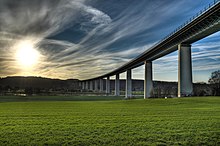Mulheim an der Ruhr
Mülheim an der Ruhr is a German city in the state of North Rhine-Westphalia, located between the cities of Essen and Duisburg, on the banks of the Ruhr. It is the headquarters of various companies, especially in the food industry, such as the Aldi Süd Company, the Harke Group and the Tengelmann Group.
History
The town belonged to the lords of Broich since 1093. In 1598 the castle and the town were occupied by Spanish troops led by Francisco López de Mendoza y Mendoza and again taken by Ambrosio Spínola in October 1605, until its occupation by troops of the United Provinces of the Netherlands in February 1609. Giving it back to its lord, Juan Adolfo de Daun, son-in-law of Juan VII of Nassau-Siegen.
In 1614, during the crisis of the Juliers-Cleveris succession, it was reoccupied by the Spanish troops led by Ambrosio Spínola, who destroyed its walls to prevent it from being used as a fortress by the Protestants.
In 1682 the town was inherited by the Leiningen family.
In 1806 it was annexed to the Grand Duchy of Berg. It received its municipal charter in 1808, passing in 1815 to the Kingdom of Prussia. One hundred years later, the population exceeded 100,000, making Mülheim an official city. At the time of the bicentennial of the city, with about 170,000 inhabitants, it was among the smallest cities in Germany.
In 1993, the city was laureate together with Bocholt with the Europe Prize, a distinction awarded annually by the Council of Europe, since 1955, to those municipalities that have made remarkable efforts to promote the ideal of European unity.
Geography
Geographic location
Mülheim an der Ruhr is located southwest of Essen, in the Ruhr area.
Geology
The northern foothills of the Rhineland massif are characterized by the characteristic rock formation of the bare slopes of the mountains, along which run carboniferous layers that formed during the carboniferous period. Here the Ruhr plunges more than 50 meters into this Mittelgebirge. This natural erosion partly exposed these exploitable black carbon deposits, which allowed their exploration and extraction by means of wells. However, the coal-rich seams got deeper and deeper as you went north, necessitating mining to extract the black coal. Instead, the broad bayou (dead arm of a river) of the municipality of Styrum is characteristic of the features of the Lower Rhine plain.
Transportation
Underground line U18 connects the city with Essen.
Demographics
It has a population of 168,925 (31 December 2007). Area: 91.26 km².
|
|
Climate
| Month | Media | Ene | Feb | Mar | Abr | May | Jun | Jul | Ago | Sep | Oct | Nov | Dic |
|---|---|---|---|---|---|---|---|---|---|---|---|---|---|
| Average maximum temperature (°C) | 13,3 | 4,5 | 5.4 | 9,2 | 12.7 | 17.6 | 19.8 | 22.1 | 22.3 | 18.4 | 13.6 | 8.3 | 5.6 |
| Average minimum temperature (°C) | 6.7 | 0.2 | 0.4 | 2.8 | 5.1 | 9,2 | 11,5 | 13.5 | 13.7 | 11,2 | 7.5 | 3.7 | 1.6 |
| Rains (mm) | 11,6 | 15 | 10 | 13 | 11 | 11 | 13 | 10 | 9 | 11 | 10 | 12 | 15 |
| Fonte: wetter10.com | |||||||||||||
Notable people
Contenido relacionado
Governor General of Canada
Holm oaks from above
New Jersey
